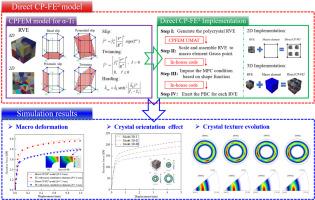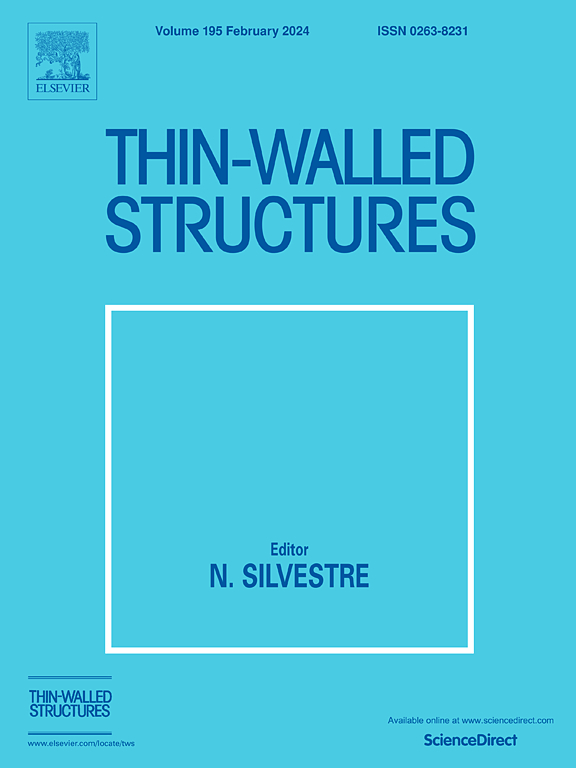A novel concurrent multiscale method based on the coupling of Direct FE2 and CPFEM
IF 5.7
1区 工程技术
Q1 ENGINEERING, CIVIL
引用次数: 0
Abstract
Performing concurrent simulations of macroscopic behaviors and microscopic structures using the crystal plasticity finite element method (CPFEM) presents a substantial difficulty with existing numerical techniques. To address this issue, a novel multi-scale method is proposed that couples CPFEM with a multiscale FEM, specifically Direct FE2. This facilitates the implementation of Direct CP-FE2 in this work. The micro representative volume elements (RVEs) equipped with a crystal plasticity constitutive model and the macro mesh are integrated into a monolithic solution scheme within the Direct FE2 framework. The proposed method integrates the multiscale simulation capability of Direct FE2 with the crystal plasticity model of CPFEM. Alpha titanium (α-Ti), which exhibits two distinct plastic mechanisms of slip and twinning, is chosen as the subject of investigation for conducting numerical experiments. The accuracy and efficiency of the Direct CP-FE2 model are evaluated through multiple plate tension and beam bending tests. The effective validation against the FEM model demonstrated the capability of Direct CP-FE2 to forecast macroscopic deformation behaviors. Meanwhile, the Direct CP-FE2 model can reveal the activation of slip/twinning systems and the evolution of crystal texture at a microscopic level. The influence of the grain orientation-dependent effect can be well considered into the macroscopic analysis with the help of Direct CP-FE2. Based on the testing examples, we demonstrate that the yield state of the macrostructure is enhanced when the crystal orientation is closer to the (0001) direction. Consequently, there exist very little crystal rotation behavior, hindering the evolution of the crystal texture.

基于直接 FE2 和 CPFEM 耦合的新型并行多尺度方法
使用晶体塑性有限元法(CPFEM)同时模拟宏观行为和微观结构是现有数值技术的一大难题。为了解决这个问题,我们提出了一种新颖的多尺度方法,将 CPFEM 与多尺度有限元方法(特别是 Direct FE2)结合起来。这为本研究中直接 CP-FE2 的实施提供了便利。在 Direct FE2 框架内,配备晶体塑性构成模型的微观代表体积元素(RVE)和宏观网格被集成到一个整体求解方案中。所提出的方法集成了 Direct FE2 的多尺度模拟能力和 CPFEM 的晶体塑性模型。α-钛(α-Ti)具有滑移和孪晶两种不同的塑性机制,因此被选为进行数值实验的研究对象。通过多次板拉伸和梁弯曲试验,评估了直接 CP-FE2 模型的准确性和效率。与有限元模型的有效验证证明了直接 CP-FE2 预测宏观变形行为的能力。同时,Direct CP-FE2 模型还能在微观层面揭示滑移/孪晶系统的激活和晶体纹理的演变。在直接 CP-FE2 的帮助下,宏观分析可以很好地考虑晶粒取向相关效应的影响。基于测试实例,我们证明了当晶体取向更接近(0001)方向时,宏观结构的屈服状态会增强。因此,几乎不存在晶体旋转行为,从而阻碍了晶体纹理的演化。
本文章由计算机程序翻译,如有差异,请以英文原文为准。
求助全文
约1分钟内获得全文
求助全文
来源期刊

Thin-Walled Structures
工程技术-工程:土木
CiteScore
9.60
自引率
20.30%
发文量
801
审稿时长
66 days
期刊介绍:
Thin-walled structures comprises an important and growing proportion of engineering construction with areas of application becoming increasingly diverse, ranging from aircraft, bridges, ships and oil rigs to storage vessels, industrial buildings and warehouses.
Many factors, including cost and weight economy, new materials and processes and the growth of powerful methods of analysis have contributed to this growth, and led to the need for a journal which concentrates specifically on structures in which problems arise due to the thinness of the walls. This field includes cold– formed sections, plate and shell structures, reinforced plastics structures and aluminium structures, and is of importance in many branches of engineering.
The primary criterion for consideration of papers in Thin–Walled Structures is that they must be concerned with thin–walled structures or the basic problems inherent in thin–walled structures. Provided this criterion is satisfied no restriction is placed on the type of construction, material or field of application. Papers on theory, experiment, design, etc., are published and it is expected that many papers will contain aspects of all three.
 求助内容:
求助内容: 应助结果提醒方式:
应助结果提醒方式:


